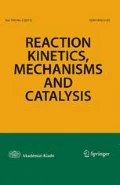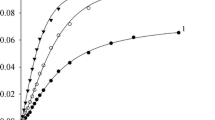Abstract
The effects of temperature and CO pressure on the rate of cyclohexene hydrocarbomethoxlyation catalyzed by the system of Pd(OAc)2/trans-2,3-bis(diphenylphosphinemethyl)norbornane (TBDPN)/p-toluenesulfonic acid (TsOH) system were studied. It was found that in the 358–373 K temperature range, reaction rates correlated with CO pressure with maximums in the range of 2.1–3.1 MPa. The results were interpreted via a hydride mechanism including diphosphine palladium complexes as intermediates, augmented with ligand exchange reactions, which lower palladium catalyst activity. The ascending branches of the reaction rate versus CO pressure curves are due to the CO acting as a reagent in the catalytic cycle, while the descending branches were interpreted in the framework of low reactivity Pd(TBDPN)(CO)2 complex formation at high CO pressures. Several effective rate constants were estimated at the 343–373 K range using least squares method. The effective activation energy was determined based on the temperature correlation with one of these constants. By analyzing the effective activation energies of cyclohexene hydrocarbomethoxylation, we were able to gauge the changes in enthalpy, entropy and Gibbs free energy in ligand exchange reactions between “ballast” palladium complexes, such as Pd(TBDPN)3, Pd(TBDPN)(CO)2 and [HPd(TBDPN)(CH3OH)]TsO. The relative stability ranges and formation entropies of these complexes were determined under the conditions of cyclohexene hydrocarbomethoxylation. Based on our understanding of the heating effect of ligand exchange reactions between Pd(TBDPN)(CO)2 and [HPd(TBDPN)(CH3OH)]TsO complexes, we determined that the binding energy of CO molecules is 7 kJ/mol higher than the binding energy of diphosphine TBDPN molecules (without chelate formation). Based on the entropy changes in ligand exchange reactions, we propose that the [HPd(TBDPN)(CH3OH)]TsO complex is practically undissociated in these conditions. The analysis of changes in Gibbs free energy showed that in palladium ligand exchange, under the conditions in question, Pd(TBDPN)3 formation is thermodynamically favorable.







Similar content being viewed by others
References
Vavasori A, Cavinato G, Toniolo L (2001) J Mol Catal A: Chem 176:11–18
Liu J, Heaton BT, Iggo JA, Whyman R (2004) Chem Commun, pp 1326–1327
Cavinato G, Toniolo L, Vavasori A (2004) J Mol Catal A: Chem 219:233–240
Amadio E, Cavinato G, Härter P, Toniolo L (2013) J Organomet Chem 745–746:115–119
Rosales M, Pacheco I, Medira J, Fernandez J, Gonzalez A, Izquierdo R, Melean LG, Baricelli PJ (2014) Catall Lett 144:1717–1727
Rodriguez CJ, Foster DF, Eastham GR, Cole-Hamilton DJ (2004) Chem Commun, pp 1720–1721
Kron TE, Petrov ES (2003) Petrol Chem 43:375–378
Aver’yanov VA, Batashev SA, Sevostianova NT, Zarytovsky VM (2005) Catal Ind, pp 25–33
Vavasori A, Toniolo L, Cavinato G (2003) J Mol Catal A: Chem 191:9–21
Blanco C, Godard C, Zangrando E, Ruiz A, Claver C (2012) Dalton Trans 41:6980–6991
Ionescu A, Laurenczy G, Wendt OF (2006) Dalton Trans, pp 3934–3940
Grabulosa A, Frew JJR, Fuentes JA, Slawin AMZ, Clarke ML (2010) J Mol Catal A: Chem 330:18–25
Noskov YG, Petrov ES (2001) Russ Chem Bull 50:1839–1843
Tang C-M, Zeng Y, Yang X-G, Lei Y-C, Wang G-Y (2009) J Mol Catal A: Chem 314:15–20
Kron TE, Terekhova MI, Noskov YG, Petrov ES (2001) Kinet Catal 42:182–188
Kron TE, Terekhova MI, Petrov ES (2004) Kinet Catal 45:519–521
Nifant’ev IE, Batashev SA, Toloraya SA, Tavtorkin AN, Sevostyanova NT, Vorobiev AA, Bagrov VV, Averyanov VA (2011) J Mol Catal A: Chem 350:64–68
Nifant’ev IE, Sevostyanova NT, Averyanov VA, Batashev SA, Vorobiev AA, Toloraya SA, Bagrov VV, Tavtorkin AN (2012) Appl Catal A Gen 449:145–152
Aver’yanov VA, Batashev SA, Sevost’yanova NT, Nosova NM (2006) Kinet Catal 47:375–383
Aver’yanov VA, Sevost’yanova NT, Batashev SA, Demerlii AM (2013) Petrol Chem 53:39–45
Averyanov VA, Sevostyanova NT, Batashev SA, Vorob’ev AA, Rodionova AS (2014) Russ J Phys Chem B 8:140–147
Sevostyanova NT, Averyanov VA, Batashev SA, Rodionova AS, Vorob’ev AA (2014) Russ Chem Bull 63:837–842
Aver’yanov VA, Sevost’yanova NT, Batashev SA, Nesolenaya SV (2006) Petrol Chem 46:405–414
Aver’yanov VA, Sevost’yanova NT, Batashev SA (2008) Petrol Chem 48:287–295
Nifant’ev I, Sevostyanova N, Batashev S, Vorobiev A, Tavtorkin A (2015) React Kinet Mech Catal 116:63–77
Terekhova MI, Sigalov AB, Petrova NE, Petrov ES (1985) J Gen Chem USSR 55:944–945
Verspui G, Moiseev I, Sheldon RA (1999) J Organomet Chem 586:196–199
Noskov YuG, Simonov AI, Petrov ES (2000) Kinet Catal 41:511–516
Seayad A, Jayasree S, Damodaran K, Toniolo L, Chaudhari RV (2000) J Organomet Chem 601:100–107
Terekhova MI, Petrova NE, Shifrina RR, Petrov ES (1988) J Gen Chem USSR 58:658–661
Bardi R, Piazzasi AM, Cavinato G, Toniolo L (1985) Inorg Chim Acta 102:99–103
Bardi R, Del Pra A, Piazzasi AM, Toniolo L (1979) Inorg Chim Acta 35:L345–L346
Cavinato G, Toniolo L (1979) J Mol Catal A: Chem 6:111–122
Kiss G (2001) Chem Rev 101:3435–3456
Seayad A, Kelkar AA, Toniolo L, Chaudhari RV (2000) J Mol Catal A: Chem 151:47–59
Petrov ES, Noskov YG (1998) Ross Khim Zh 42:149–157
Yoshida H, Sugita N, Kudo K, Takezaki Y (1976) Bull Chem Soc Jpn 49:2245–2249
Acknowledgments
This study was supported by the Russian Foundation for Basic Research within the framework of project no. 14-08-00535, and by the Russian Science Foundation, Grant no. 15-13-00053.
Author information
Authors and Affiliations
Corresponding author
Rights and permissions
About this article
Cite this article
Nifant’ev, I., Sevostyanova, N., Batashev, S. et al. Kinetic aspects of the influence of CO pressure on cyclohexene hydrocarbomethoxylation catalyzed by a diphosphine palladium system. Thermodynamic characteristics of some ligand exchange reactions. Reac Kinet Mech Cat 119, 75–91 (2016). https://doi.org/10.1007/s11144-016-1048-z
Received:
Accepted:
Published:
Issue Date:
DOI: https://doi.org/10.1007/s11144-016-1048-z



